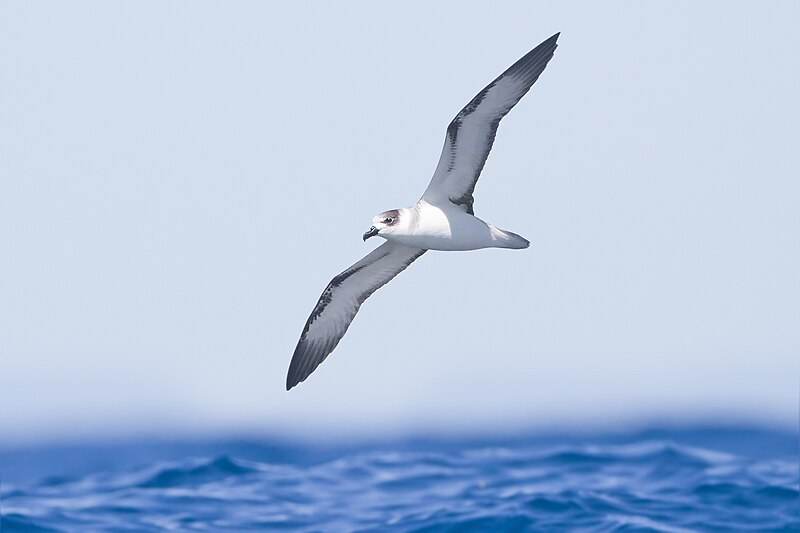.
Great Shearwater (Puffinus gravis), East of the Tasman Peninsula, Tasmania, Australia: photo by JJ Harrison, 22 April 2012
What birds were they? He stood on the steps of the library to look at them, leaning wearily on his ashplant. They flew round and round the jutting shoulder of a house in Molesworth Street. The air of the late March evening made clear their flight, their dark quivering bodies flying clearly against the sky as against a limphung cloth of smoky tenuous blue.
He watched their flight; bird after bird: a dark flash, a swerve, a flash again, a dart aside, a curve, a flutter of wings. He tried to count them before all their darting quivering bodies passed: six, ten, eleven: and wondered were they odd or even in number. Twelve, thirteen: for two came wheeling down from the upper sky. They were flying high and low but ever round and round in straight and curving lines and ever flying from left to right, circling about a temple of air.
He listened to the cries: like the squeak of mice behind the wainscot: a shrill twofold note. But the notes were long and shrill and whirring, unlike the cry of vermin, falling a third or a fourth and trilled as the flying beaks clove the air. Their cry was shrill and clear and fine and falling like threads of silken light unwound from whirring spools.
The inhuman clamour soothed his ears in which his mother's sobs and reproaches murmured insistently and the dark frail quivering bodies wheeling and fluttering and swerving round an airy temple of the tenuous sky soothed his eyes which still saw the image of his mother's face.
Why was he gazing upwards from the steps of the porch, hearing their shrill twofold cry, watching their flight? For an augury of good or evil? A phrase of Cornelius Agrippa flew through his mind and then there flew hither and thither shapeless thoughts from Swedenborg on the correspondence of birds to things of the intellect and of how the creatures of the air have their knowledge and know their times and seasons because they, unlike man, are in the order of their life and have not perverted that order by reason.
And for ages men had gazed upward as he was gazing at birds in flight. The colonnade above him made him think vaguely of an ancient temple and the ashplant on which he leaned wearily of the curved stick of an augur. A sense of fear of the unknown moved in the heart of his weariness, a fear of symbols and portents, of the hawklike man whose name he bore soaring out of his captivity on osierwoven wings, of Thoth, the god of writers, writing with a reed upon a tablet and bearing on his narrow ibis head the cusped moon.
James Joyce: from A Portrait of the Artist as a Young Man (1914-1915, published in book form 1916)

Red-necked Avocet (Recurvirostra novaehollandiae), Lake Joondalup, Perth, Western Australia, photo by JJ Harrison, 19 March 2012

White-necked Petrel (Pterodroma cervicalis), East of the Tasman Peninsula, Tasmania, Australia: photo by JJ Harrison, 4 February 2012




No comments:
Post a Comment